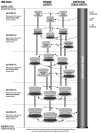Building health behavior models to guide the development of just-in-time adaptive interventions: A pragmatic framework
- PMID: 26651462
- PMCID: PMC4732268
- DOI: 10.1037/hea0000306
Building health behavior models to guide the development of just-in-time adaptive interventions: A pragmatic framework
Abstract
Advances in wireless devices and mobile technology offer many opportunities for delivering just-in-time adaptive interventions (JITAIs)-suites of interventions that adapt over time to an individual's changing status and circumstances with the goal to address the individual's need for support, whenever this need arises. A major challenge confronting behavioral scientists aiming to develop a JITAI concerns the selection and integration of existing empirical, theoretical and practical evidence into a scientific model that can inform the construction of a JITAI and help identify scientific gaps. The purpose of this paper is to establish a pragmatic framework that can be used to organize existing evidence into a useful model for JITAI construction. This framework involves clarifying the conceptual purpose of a JITAI, namely, the provision of just-in-time support via adaptation, as well as describing the components of a JITAI and articulating a list of concrete questions to guide the establishment of a useful model for JITAI construction. The proposed framework includes an organizing scheme for translating the relatively static scientific models underlying many health behavior interventions into a more dynamic model that better incorporates the element of time. This framework will help to guide the next generation of empirical work to support the creation of effective JITAIs.
(PsycINFO Database Record (c) 2015 APA, all rights reserved).
Figures
Similar articles
-
Just-in-Time Adaptive Interventions (JITAIs) in Mobile Health: Key Components and Design Principles for Ongoing Health Behavior Support.Ann Behav Med. 2018 May 18;52(6):446-462. doi: 10.1007/s12160-016-9830-8. Ann Behav Med. 2018. PMID: 27663578 Free PMC article.
-
Microrandomized trials: An experimental design for developing just-in-time adaptive interventions.Health Psychol. 2015 Dec;34S(0):1220-8. doi: 10.1037/hea0000305. Health Psychol. 2015. PMID: 26651463 Free PMC article.
-
Exploring the Feasibility of Using ChatGPT to Create Just-in-Time Adaptive Physical Activity mHealth Intervention Content: Case Study.JMIR Med Educ. 2024 Feb 29;10:e51426. doi: 10.2196/51426. JMIR Med Educ. 2024. PMID: 38421689 Free PMC article.
-
Just-in-Time Adaptive Mechanisms of Popular Mobile Apps for Individuals With Depression: Systematic App Search and Literature Review.J Med Internet Res. 2021 Sep 28;23(9):e29412. doi: 10.2196/29412. J Med Internet Res. 2021. PMID: 34309569 Free PMC article.
-
Beyond the current state of just-in-time adaptive interventions in mental health: a qualitative systematic review.Front Digit Health. 2025 Jan 28;7:1460167. doi: 10.3389/fdgth.2025.1460167. eCollection 2025. Front Digit Health. 2025. PMID: 39935463 Free PMC article.
Cited by
-
Just-in-Time Adaptive Interventions (JITAIs) in Mobile Health: Key Components and Design Principles for Ongoing Health Behavior Support.Ann Behav Med. 2018 May 18;52(6):446-462. doi: 10.1007/s12160-016-9830-8. Ann Behav Med. 2018. PMID: 27663578 Free PMC article.
-
A Personalized, Transdiagnostic Smartphone Intervention (Mello) Targeting Repetitive Negative Thinking in Young People With Depression and Anxiety: Pilot Randomized Controlled Trial.J Med Internet Res. 2023 Dec 13;25:e47860. doi: 10.2196/47860. J Med Internet Res. 2023. PMID: 38090786 Free PMC article. Clinical Trial.
-
Acceptability of a Text Message-Based Mobile Health Intervention to Promote Physical Activity in Cardiac Rehabilitation Enrollees: A Qualitative Substudy of Participant Perspectives.J Am Heart Assoc. 2024 Jan 16;13(2):e030807. doi: 10.1161/JAHA.123.030807. Epub 2024 Jan 16. J Am Heart Assoc. 2024. PMID: 38226512 Free PMC article. Clinical Trial.
-
PEACH, a smartphone- and conversational agent-based coaching intervention for intentional personality change: study protocol of a randomized, wait-list controlled trial.BMC Psychol. 2018 Sep 4;6(1):43. doi: 10.1186/s40359-018-0257-9. BMC Psychol. 2018. PMID: 30180880 Free PMC article.
-
Advancing Behavioral Intervention and Theory Development for Mobile Health: The HeartSteps II Protocol.Int J Environ Res Public Health. 2022 Feb 17;19(4):2267. doi: 10.3390/ijerph19042267. Int J Environ Res Public Health. 2022. PMID: 35206455 Free PMC article.
References
-
- Armeli S, Todd M, Mohr C. A daily process approach to individual differences in stress-related alcohol use. Journal of Personality. 2005;73(6):1657–1686. - PubMed
-
- Bolger N, Laurenceau JP. Intensive longitudinal methods: An introduction to diary and experience sampling research. New York, NY: Guilford Press; 2013.
Publication types
MeSH terms
Grants and funding
LinkOut - more resources
Full Text Sources
Other Literature Sources
Medical




